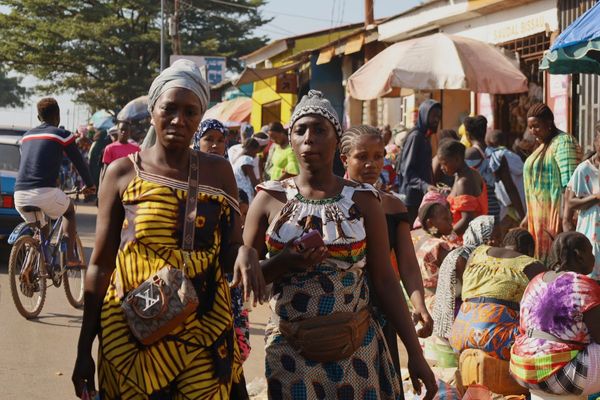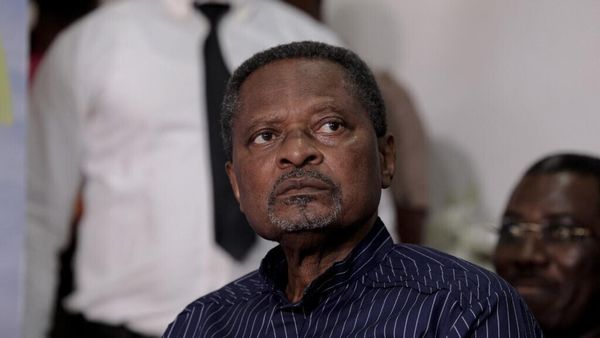
The banks of the Murray are sandy and broad as they wind around the city of Mildura in Victoria’s far north-west. They are beloved by locals and visitors – and were also the feature of a recent, much maligned tourism campaign, fronted by actor Shane Jacobson and surf life-savers, likening the inland river city to the far north Queensland coast.
The $390,000 campaign, which bills Mildura as “tropical north Victoria”, has been widely panned by locals since it launched a year ago. But it’s not the first time the city has taken the loud and brash approach to putting itself on the cultural map in the last few years. American rock band Kings of Leon played there in 2022, then earlier this year Lenny Kravitz announced he would take in the Murray on his national tour.
So what’s going on in Mildura? Why is it trying so hard to grab the nation’s attention – and is it working?
Food bowl
There’s no getting around the issue of distance, for locals or for tourists. It’s a four-hour drive to Mildura from Adelaide, and six from Melbourne. There has been no direct train from Melbourne for 30 years. Public transport users either need to fly there – the cost of which has skyrocketed since the collapse of low-cost airline Bonza – or make at least part of the journey in a roundabout way by coach. It’s a significant barrier, given tourist data shows two-thirds of visitors to the Murray region are other Victorians.
Tourism is worth about $308m a year to Mildura, but agriculture dwarfs it. Citrus fruits, table grapes, almonds and vegetables are all produced there, and the sector contributes about $1.13bn a year to the economy when combined with forestry and fishing.
Horticulture and migrant workers have long defined the town: first in the postwar influx of Italian migrants, who set up the market gardens, and in more recent years waves of backpackers and fruit pickers from the Pacific Islands. Yet healthcare and services in the region employ more people than agriculture.
For Mallee-based anthropologist and ex-university academic Melinda Hinkson, the contradictions of the region can be seen in the decline of small-scale farming, leaving what locals call a “Swiss-cheese” landscape of abandoned lots, alongside the explosion in large-scale agricultural conglomerates.
“You’ve got this hugely successful but precarious large-ag economy, side by side the dramatic shrinkage of small farms,” Hinkson says.
Her forthcoming documentary, Flip the Food Bowl, depicts the absurdity of a system that puts locally grown produce on supermarket shelves in Mildura, only it’s many days old by the time it gets there, having been exported down to Melbourne and back again first. Farm-gate fresh produce is readily available at markets, but it’s not the norm for the major chains.
Population growth and diversifying the economy have been key parts of the region’s development strategy for more than a decade. But the population has not been growing as fast as projected, and those who are coming to live in the city are often moving in from surrounding hamlets or farmland, and were already relying on Mildura for services.
Cooperatives and smaller-scale farming ventures began to fail after the federal government dismantled support for them in the 80s and 90s, leaving them fully exposed to market forces and the domination of huge corporations, Hinkson explains. Mum-and-dad farms were bought up or went bust. “We’ve just been watching the entrenchment of those effects over time … And you end up with the urbanisation of rural communities.”
As with all regional communities, access to healthcare is an issue for locals. Drought is an ever-present threat, while the climate crisis couples long dry spells with heavy downpours – such as the rains that caused the 2022 floods – that challenge public infrastructure. In the long term, the environment is expected to shift to be more like Menindee, a desert oasis 250km to the north.
There are opportunities for the region in the diversification of agriculture to accommodate these challenges, Hinkson says, if state and federal governments were willing to support them.
“There’s always been this super committed creative community, all the way back to the creation of the irrigated colony, and in much more recent times around creative industry and the arts in particular,” Hinkson says.
Public art push
“I think arts and culture is a huge opportunity for us from a tourism perspective,” says Mildura mayor Helen Healy.
She offers the Mildura writers festival, which opened on Thursday, as a case in point: it marks its 30th year this month, and most of the events were sold out in advance. It pairs perhaps naturally with a food and wine culture, with chef Stefano di Pieri’s restaurant only the most widely known of the region’s offerings for gourmands.
But the city has also been supporting other arts, and sculpture in particular. There are light installations by Bruce Munro along the river, and Healy says she has been in negotiations to move “a major sculpture work” into the region. The sculpture triennials that ran in Mildura in the 1960s and 70s were crucial to the development of a market for modern sculpture in Australia, and Healy has been lobbying to have Mildura declared a city of public art. Powerhouse Place, an events and exhibition space on the banks of the Murray, won two Australian architecture awards last year.
Visitor numbers have been moderately healthy, if fluctuating, since Covid lockdowns lifted in Victoria at the end of 2021, but have not so far exceeded their pre-Covid peak.
Healy admits the “tropical north Victoria” tourism campaign was “cheeky” – “some people took it a bit seriously; I mean, it was Shane Jacobson for goodness sake” – but claims the tongue-in-cheek approach, or perhaps the resulting snark, has started paying off. She says visitor spending over the Easter period was up 10% from last year, and July school holiday bookings up 257%.
“We’ve had the kind of exposure we could never have afforded to pay for from that campaign,” Healy says. “For many reasons, we’re considered remote and regional and isolated, so we’ve got to make a lot of things happen for ourselves. We’ve got to be bold and out there.”
The distance also has a political impact, with a longstanding sense that Mildura is often out of sight, out of mind for many, especially politicians.
“Often we bemoan the fact that state governments can think that the state ends about an hour out of Melbourne,” Healy says. “We’re quite disadvantaged when it comes to access to public transport. It would be great to have our train back, [and] we need a bigger hospital. The state government did have plans for a new hospital to be built, so that’s been on the back-burner for a while. We’d like to see that back on the table.”
Despite that, Healy says the region has had “some really good wins” with the state government recently. The aforementioned sporting precinct redevelopment is one of those, as is the Kravitz tour, and the Kings of Leon show before that.
“We’re not completely neglected at all, but we’re very aware that we’re in a safe seat and sometimes when elections come, we don’t have politicians bearing gifts.”







